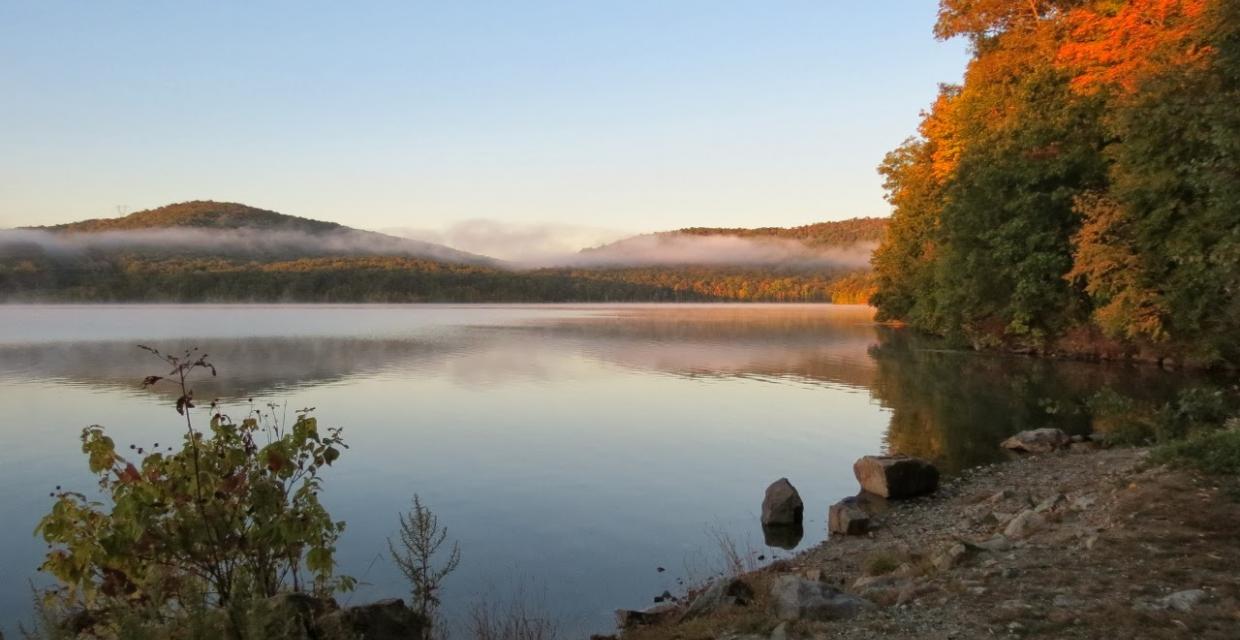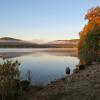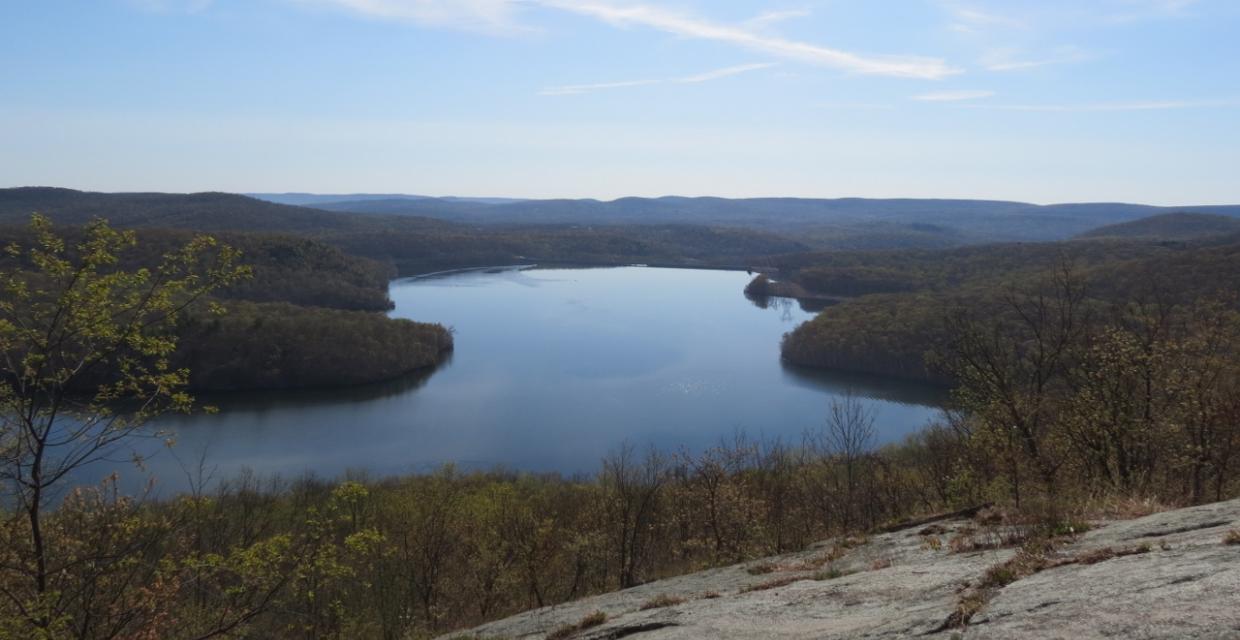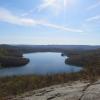Long Pond Ironworks State Park




Park Overview:
Long Pond Ironworks State Park contains the remnants of ironworks operating from 1766 to 1886, two other pre-Civil War furnaces and two waterwheels surviving to this day. A visitor center and museum are on site.
Park Description:
Long Pond Ironworks State Park
The Monksville Reservoir dominates Long Pond Ironworks State Park. Historically, Long Pond, later called Greenwood Lake, gained prominence when Peter Hasenclever directed the construction of a dam across the southern end of Long Pond to provide water power for his ironworks downstream in the Hewitt area. Long Pond Ironworks was built in 1766 on Long Pond River, now known as the Wanaque. Just before the Civil War, two more furnaces were built with two waterwheels, and were in operation until 1882. The ruins of these structures survive in the park today, including several relocated historic frame buildings.
Check the Friends of Long Pond Ironworks website for the seasonal schedule for tours of the furnace area and village and the hours for the Long Pond Visitors Center. For more information, call (973) 657-1688.
In 2009, the former Wanaque Wildlife Management Area was incorporated into this state park. Its 2,320 acres are located adjacent to and just east of Greenwood Lake, and are currently used primarily for hunting and fishing.
Trails Overview:
Three trails in the State Park lead to remnants of the historic mines and ironworks: The Sterling Ridge Trail [blue on white blaze] - co-aligned with the Highlands Trail [teal] -- the Monks Trail [white blaze] and the Whritenour Mine Trail [yellow blaze, marked "unmaintained" on Trail Conference Map 115]. Trails range from 0.4 to 8.6 miles. Use Web Map link on this web site to view a NJ State Pak Service map.
A section of the Highlands Trail runs through the park. Visit The Highlands Trail website for complete, accurate and up-to-date information about New Jersey's Millennium Trail, including trail descriptions, current trail conditions and maps.
The former Wildlife Management Area of the park includes portions of the Highlands, Sterling Ridge and Hasenclever Iron trails, plus a network of unmarked woods roads with access from adjoining paved roads. The Jennings Hollow Trail [3.0 miles; yellow] starts from the Sterling Ridge Trail [blue on white] 1.1 miles from its southern trailhead at the intersection of East Shore Drive and Greenwood Lake Turnpike. One highlight is a view across an extensive wetland along the return segment of the loop. Jennings Creek is impressive in flood, especially when looking for underwater stepping stones.
- Note: From East Shore Drive a trail/woods road identified as Jennings Hollow Fire Road, which is a little steep and rugged in places, leads 0.3 mile to the loop portion of the Jennings Hollow Trail. Roadside dirt parking for a few cars is directly across East Shore Road.
The long-awaited replacement footbridge for the one that was washed away by Hurricane Irene in 2011 was completed in late 2016. The bridge is a strategic link over the Wanaque River for the Hasenclever Iron Trail and the Highlands Trail.
Click to find detailed descriptions of several hikes in the park.
Park Acreage:
6911.00 acresMunicipality:
West Millford (Hewitt area), RingwoodLong Pond Ironworks State Park contains the remnants of ironworks operating from 1766 to 1886, two other pre-Civil War furnaces and two waterwheels surviving to this day. A visitor center and museum are on site.
Long Pond Ironworks State Park
The Monksville Reservoir dominates Long Pond Ironworks State Park. Historically, Long Pond, later called Greenwood Lake, gained prominence when Peter Hasenclever directed the construction of a dam across the southern end of Long Pond to provide water power for his ironworks downstream in the Hewitt area. Long Pond Ironworks was built in 1766 on Long...
Park Acreage:
6911.00 acresMunicipality:
West Millford (Hewitt area), RingwoodContact Information
Web Link:
NJ DEP, Division of Parks and ForestryPhone:
(973) 962-7031Fees:
NoneDogs in park:
Dogs on leashHike Checklist:
Whether you are going for a day hike or backpacking overnight, it is good practice to carry what we call The Hiking Essentials. These essentials will help you enjoy your outing more and will provide basic safety gear if needed. There may also be more essentials, depending on the season and your needs.
The Essentials
Hiking Shoes or Boots
Water - Two quarts per person is recommended in every season. Keep in mind that fluid loss is heightened in winter as well as summer. Don't put yourself in the position of having to end your hike early because you have run out of water.
Map - Know where you are and where you are going. Many of our hiking areas feature interconnecting network of trails. Use a waterproof/tear-resistant Tyvek Trail Conference map if available or enclose your map in a Ziplock plastic bag. If you have a mobile device, download Avenza’s free PDF Maps app and grab some GPS-enhanced Trail Conference maps (a backup Tyvek or paper version of the map is good to have just in case your batteries die or you don't have service). Check out some map-reading basics here.
Food - Snacks/lunch will keep you going as you burn energy walking or climbing. Nuts, seeds, and chocolate are favorites on the trail.
Sunscreen and insect repellent
Rain Gear and Extra Clothing - Rain happens. So does cold. Be prepared for changing weather. Avoid cotton--it traps water against your skin and is slow to dry. If you are wearing wet cotton and must return to your starting point, you risk getting chills that may lead to a dangerous hypothermia. Choose synthetic shirts, sweaters and/or vests and dress in layers for easy on and off.
Compass - A simple compass is all you need to orient you and your map to magnetic north.
Light - A flashlight or small, lightweight headlamp will be welcome gear if you find yourself still on the trail when darkness falls. Check the batteries before you start out and have extras in your pack.
First Aid Kit - Keep it simple, compact, and weatherproof. Know how to use the basic components.
Firestarter and Matches - In an emergency, you may need to keep yourself or someone else warm until help arrives. A firestarter (this could be as simple as leftover birthday candles that are kept inside a waterproof container) and matches (again, make sure to keep them in a waterproof container) could save a life.
Knife or Multi-tool - You may need to cut a piece of moleskin to put over a blister, repair a piece of broken equipment, or solve some other unexpected problem.
Emergency Numbers - Know the emergency numbers for the area you're going to and realize that in many locations--especially mountainous ones, your phone will not get reception.
Common Sense - Pay attention to your environment, your energy, and the condition of your companions. Has the weather turned rainy? Is daylight fading? Did you drink all your water? Did your companion fail to bring rain gear? Are you getting tired? Keep in mind that until you turn around you are (typically) only half-way to completing your hike--you must still get back to where you started from! (Exceptions are loop hikes.)
Check the weather forecast before you head out. Know the rules and regulations of the area.
The Leave No Trace Seven Principles
Plan Ahead and Prepare
- Know the regulations and special concerns for the area you'll visit.
- Prepare for extreme weather, hazards, and emergencies.
- Schedule your trip to avoid times of high use.
- Visit in small groups when possible. Consider splitting larger groups into smaller groups.
- Repackage food to minimize waste.
- Use a map and compass to eliminate the use of marking paint, rock cairns or flagging.
Travel and Camp on Durable Surfaces
- Durable surfaces include established trails and campsites, rock, gravel, dry grasses or snow.
- Protect riparian areas by camping at least 200 feet from lakes and streams.
- Good campsites are found, not made. Altering a site is not necessary.
- In popular areas:
- Concentrate use on existing trails and campsites.
- Walk single file in the middle of the trail, even when wet or muddy.
- Keep campsites small. Focus activity in areas where vegetation is absent.
- In pristine areas:
- Disperse use to prevent the creation of campsites and trails.
- Avoid places where impacts are just beginning.
- Pack it in, pack it out. Inspect your campsite and rest areas for trash or spilled foods. Pack out all trash, leftover food and litter.
- Deposit solid human waste in catholes dug 6 to 8 inches deep, at least 200 feet from water, camp and trails. Cover and disguise the cathole when finished.
- Pack out toilet paper and hygiene products.
- To wash yourself or your dishes, carry water 200 feet away from streams or lakes and use small amounts of biodegradable soap. Scatter strained dishwater.
- Preserve the past: examine, but do not touch cultural or historic structures and artifacts.
- Leave rocks, plants and other natural objects as you find them.
- Avoid introducing or transporting non-native species.
- Do not build structures, furniture, or dig trenches.
- Campfires can cause lasting impacts to the backcountry. Use a lightweight stove for cooking and enjoy a candle lantern for light.
- Where fires are permitted, use established fire rings, fire pans, or mound fires.
- Keep fires small. Only use sticks from the ground that can be broken by hand.
- Burn all wood and coals to ash, put out campfires completely, then scatter cool ashes.
- Observe wildlife from a distance. Do not follow or approach them.
- Never feed animals. Feeding wildlife damages their health, alters natural behaviors, and exposes them to predators and other dangers.
- Protect wildlife and your food by storing rations and trash securely.
- Control pets at all times, or leave them at home.
- Avoid wildlife during sensitive times: mating, nesting, raising young, or winter.
Be Considerate of Other Visitors
- Respect other visitors and protect the quality of their experience.
- Be courteous. Yield to other users on the trail.
- Step to the downhill side of the trail when encountering pack stock.
- Take breaks and camp away from trails and other visitors.
- Let nature's sounds prevail. Avoid loud voices and noises.
The Trail Conference is a 2015 Leave No Trace partner.
(c) Leave No Trace Center for Outdoor Ethics: www.LNT.org.


